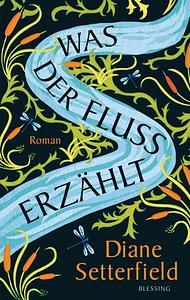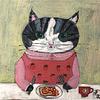You need to sign in or sign up before continuing.
Take a photo of a barcode or cover
emotional
mysterious
medium-paced
I read to be entertained and educated and while Ms Setterfield is a capable and entertaining writer I felt a little let down by the lack of historical research. There was a little of Victorian photography, but other than that almost nothing, which I found a little disappointing, especially in a historical fiction novel. I think this, for me, while generalising, sums up the main difference between male and female writers. I prefer more background and less of the relationships, which is not a criticism, just a personal preference.
Of course there are exceptions and I could name some female writers that I will always look for on the bookshelf, but they are in the minority.
Nice Prose, well told but probably my last by this author.
Of course there are exceptions and I could name some female writers that I will always look for on the bookshelf, but they are in the minority.
Nice Prose, well told but probably my last by this author.
We are taken on a journey of storytelling, meandering along like the river and we we keep going, following characters, without knowing what lies ahead. This was a Bookclub read, quite different to The Thirteenth Tale, the only other book, I’ve read written by the same author. Must read more of her books. This was an easy read and I enjoyed the ride.
No one really knows how storytelling started at the Swan, an inn and public house on the Thames, but the lilt of a tall tale is as much a fixture of the place as the sound of the river flowing beside it. One night, the Swan's door opens to a raging storm, an injured man, and a drowned girl who comes back to life right under the nose of an eminently practical nurse. Regulars used to spinning yarns find themselves caught in the middle of the greatest story they will ever tell.
For years the story has no clear beginning and no ending-- the once-dead girl is mute and three families claim her as their own. As the Swan's bards speculate endlessly, imagining pasts and futures for the child, she goes home with a wealthy couple. Is she their daughter, Amelia, who was kidnapped two years before? Perhaps she belongs to the fair-haired young man who abandoned his wife and baby to a house of ill-repute in the next town over. Apparently contrite, he faints in the child's presence and claims he cannot be certain if she is his little girl, Alice. Or maybe she is a local housekeeper's sister, drowned long ago and miraculously returned from the river's depths. As the search for the child's identity unfolds, Setterfield reveals the secrets and losses behind each family's claim to her.
Once Upon a River's delightfully gothic beginning (it was a dark and stormy night...) and its somewhat ambiguous ending bracket a powerful story that can't really be confined to a single genre. Setterfield's deft combination of conventions borrowed from historical fiction, magical realism, romance, and mystery makes for a great read. If you're new to this author's work, I'd recommend starting with The Thirteenth Tale before reading this book. It's faster-paced, has fewer characters and storylines to keep track of, and a masterful twist I never saw coming.
For years the story has no clear beginning and no ending-- the once-dead girl is mute and three families claim her as their own. As the Swan's bards speculate endlessly, imagining pasts and futures for the child, she goes home with a wealthy couple. Is she their daughter, Amelia, who was kidnapped two years before? Perhaps she belongs to the fair-haired young man who abandoned his wife and baby to a house of ill-repute in the next town over. Apparently contrite, he faints in the child's presence and claims he cannot be certain if she is his little girl, Alice. Or maybe she is a local housekeeper's sister, drowned long ago and miraculously returned from the river's depths. As the search for the child's identity unfolds, Setterfield reveals the secrets and losses behind each family's claim to her.
Once Upon a River's delightfully gothic beginning (it was a dark and stormy night...) and its somewhat ambiguous ending bracket a powerful story that can't really be confined to a single genre. Setterfield's deft combination of conventions borrowed from historical fiction, magical realism, romance, and mystery makes for a great read. If you're new to this author's work, I'd recommend starting with The Thirteenth Tale before reading this book. It's faster-paced, has fewer characters and storylines to keep track of, and a masterful twist I never saw coming.
DNF at 15%. There are too many good books out there to continue reading one I am not enjoying. The story hasn’t pulled me in at all. I loved the 13th take, and I wanted to love this, too.
Very slow start. Once it picked up, it was pretty enjoyable. Much prefer Setterfield’s “The Thirteenth Tale.”
I was so disappointed in this book, seeing how I LOVED The Thirteenth Tale by this author. But this story had too many characters, and was so slow in the set up, and then just dragged on. Guess I set my expectations too high.
Inutile paragonarlo alla Tredicesima Storia, questo romanzo sembra semplicemente un'imitazione benintenzionata da 'gruppo di scrittura creativa'.
Il ritmo della narrazione è lento e non decolla praticamente mai: ho capito che doveva ricordare una fiaba o un racconto popolare, anche con questa riflessione continua e (direi) molto banale sulla tradizione orale, però infilare capitoli-flashback per rallentare la soluzione del mistero e appesantire una trama non del tutto autonoma con valanghe di descrizioni e riflessioni trascurabili ha completamente rovinato l'atmosfera.
Ho trovato scadente il lavoro di caratterizzazione del fiume, che doveva diventare un personaggio a se stante nella trama, ma non riesce proprio ad acquistare il potere evocativo del fiume di Siddharta di Hesse, resta intrappolato in una gabbia di descrizioni ripetitive.
Il resto dei personaggi principali (Rita, Daunt, i Vaughan, ecc.) sono abbozzati e statici, solo Rob Armstrong ha raggranellato una caratterizzazione decorosa, ma solo in virtù della sua diversità.
Si intuisce che la penna è di Diane Setterfield per il tema (già esplorato) della sovrapposizione di identità, nella geminazione di questa bambina che veniva contesa da tre famiglie diverse, tutte in cerca di una figlia perduta il cui nome cominciava con la lettera A.
Non amo i bambini come protagonisti, e questo romanzo, che fa dell'istinto materno e di una bambina misteriosa i punti cardine, mi ha convinta molto poco: il fatto che la stessa sostanza, la stessa personalità possa essere rimodellata e distribuita in tre bambine diverse e il fatto che l'infanzia per Setterfield sia sinonimo di identità labile sono presentati in modo fiacco e inconcludente, le uniche argomentazioni sono chiacchiere di paese e desideri di maternità irrisolti.
Che dire, il romanzo dopo i primi due capitoli ha già detto tutto e ha già prolungato la narrazione più del necessario.
Il ritmo della narrazione è lento e non decolla praticamente mai: ho capito che doveva ricordare una fiaba o un racconto popolare, anche con questa riflessione continua e (direi) molto banale sulla tradizione orale, però infilare capitoli-flashback per rallentare la soluzione del mistero e appesantire una trama non del tutto autonoma con valanghe di descrizioni e riflessioni trascurabili ha completamente rovinato l'atmosfera.
Ho trovato scadente il lavoro di caratterizzazione del fiume, che doveva diventare un personaggio a se stante nella trama, ma non riesce proprio ad acquistare il potere evocativo del fiume di Siddharta di Hesse, resta intrappolato in una gabbia di descrizioni ripetitive.
Il resto dei personaggi principali (Rita, Daunt, i Vaughan, ecc.) sono abbozzati e statici, solo Rob Armstrong ha raggranellato una caratterizzazione decorosa, ma solo in virtù della sua diversità.
Si intuisce che la penna è di Diane Setterfield per il tema (già esplorato) della sovrapposizione di identità, nella geminazione di questa bambina che veniva contesa da tre famiglie diverse, tutte in cerca di una figlia perduta il cui nome cominciava con la lettera A.
Non amo i bambini come protagonisti, e questo romanzo, che fa dell'istinto materno e di una bambina misteriosa i punti cardine, mi ha convinta molto poco: il fatto che la stessa sostanza, la stessa personalità possa essere rimodellata e distribuita in tre bambine diverse e il fatto che l'infanzia per Setterfield sia sinonimo di identità labile sono presentati in modo fiacco e inconcludente, le uniche argomentazioni sono chiacchiere di paese e desideri di maternità irrisolti.
Che dire, il romanzo dopo i primi due capitoli ha già detto tutto e ha già prolungato la narrazione più del necessario.
Just not in the right mood. Will keep in mind for the future.







